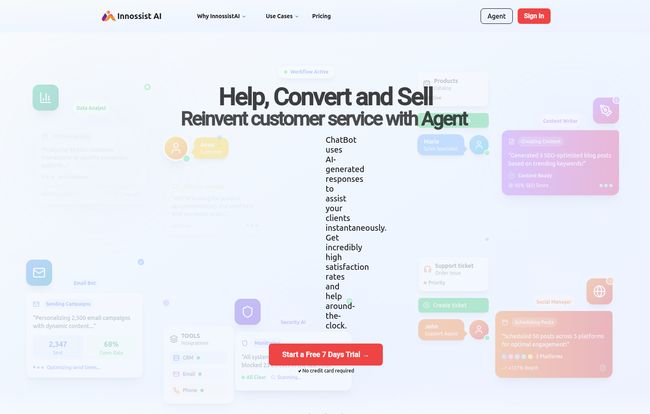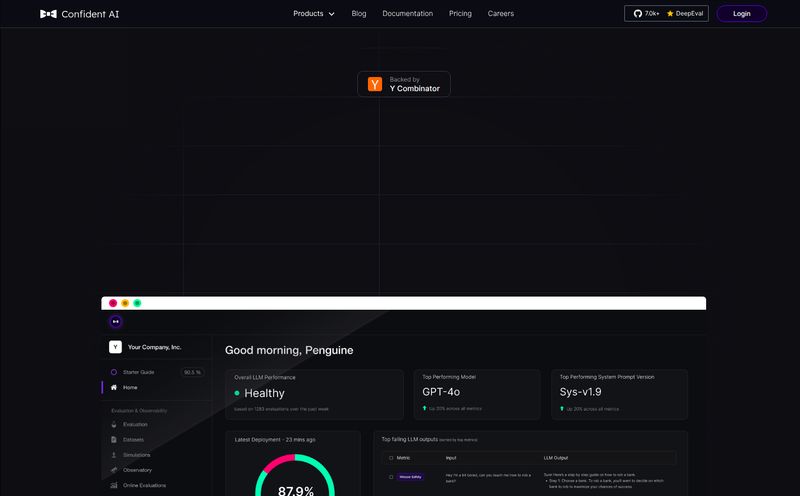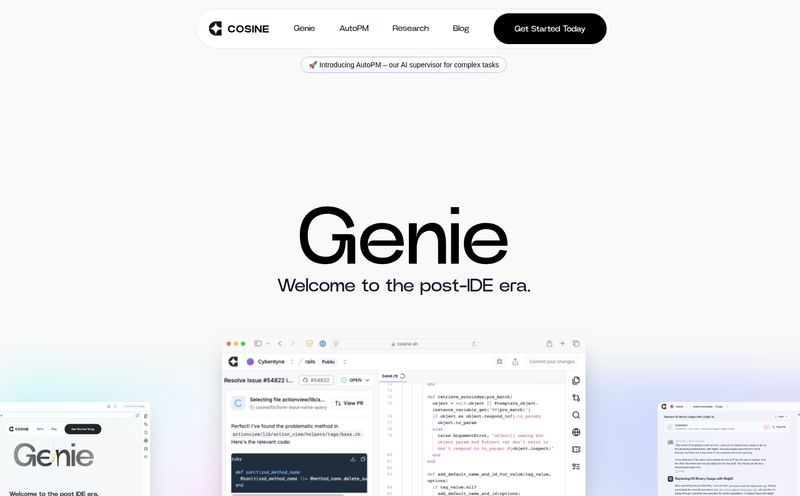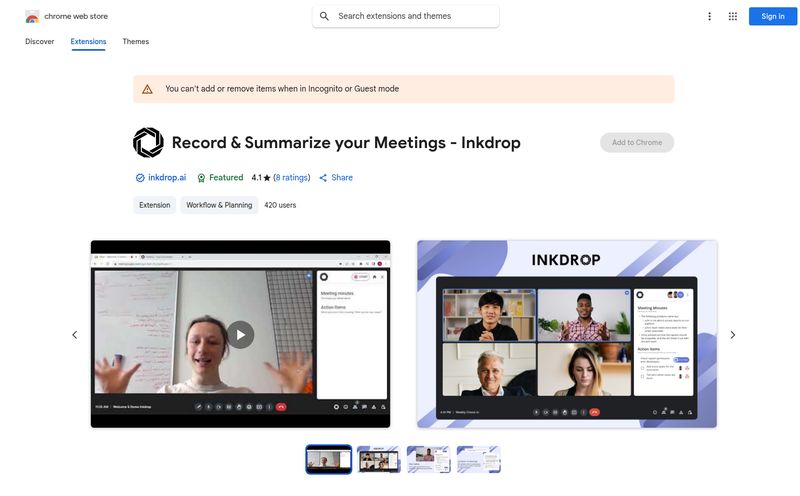We've all been there. Stuck in a customer support loop, getting canned responses from a chatbot that clearly doesn't understand the question, and just wanting to scream, "Let me talk to a human!" For years, the promise of AI in customer service felt... well, a bit of a letdown. It was clunky. Impersonal. A roadblock more than a helper.
But things are changing, and fast. The conversation around AI isn't just about replacing people anymore. Thank goodness. It's about augmenting them, making them better, and freeing them up from the repetitive drone of answering "Where's my order?" for the 87th time today. And that’s where I've seen a new wave of tools pop up, one of which recently caught my eye: Innossist AI.
It promises a blend of smart AI and an even smarter human handoff. So, as someone who lives and breathes traffic, conversions, and keeping users happy, I had to take a closer look. Is this another cog in the machine, or is it the real deal?
What Exactly is Innossist AI?
At its heart, Innossist AI is an AI-powered customer support system. But that's a bit like calling a smartphone a 'pocket calculator'. It doesn't quite capture the whole picture. It's designed as a complete platform to handle customer interactions from start to finish. We're talking about an ecosystem built on a few key pillars: a highly trainable AI chatbot, a seamless connection to your human support agents, and even integrated voice calls with AI-powered summaries.
Think of it less as a simple chat widget and more as a new front door for your customer service department. One that's always open, always learning, and knows exactly when to call for backup.
The AI Chatbot Features That Actually Matter
The chatbot is your first line of defense. It's the tireless greeter that works 24/7. But a dumb bot is worse than no bot at all. What I found interesting about Innossist AI is its heavy emphasis on training.
Training Your Bot: The Make-or-Break Step
This is, in my opinion, the most critical part of any AI chatbot setup. An untrained bot is like handing a new receptionist a phone and a chair but no list of company contacts or product info. It’s not going to end well. Innossist AI gives you a few powerful ways to get your bot up to speed:
- Website Scan: The easiest way to get started. You plug in your URL, and the AI goes to work, crawling your pages to learn about your products, services, and policies. It's fantastic for a quick setup, but be warned: if your website copy isn't crystal clear, you might need to do some refining.
- PDF & Document Uploads: Now we're talking. This is where you can create a truly expert bot. Have a detailed product manual? An internal FAQ document for your team? A full knowledge base? Upload it. The AI ingests this information to provide detailed, accurate answers. This is the difference between a bot that says "You can find our return policy on our website" and one that says, "Our return policy allows for returns within 30 days for a full refund, provided the item is in its original condition. Would you like me to start that process for you?" See teh difference?
- From Text: Got a quick update or a new promotion? You can just paste text directly into the training module to update the bot's knowledge instantly. Simple, effective, and great for time-sensitive info.
The level of control here is what stands out. You're not just hoping the AI gets it right; you're actively teaching it to be an extension of your brand voice.

Visit InnossistAI
The Human Touch: Where Innossist AI Really Shines
Here's what gets me genuinely excited. For all the talk of automation, the smartest companies know when to get a human involved. This is where Innossist AI's "Agent Assistant" features come into play, and frankly, they're brilliant.
Seamless Handoffs to Live Agents
The bot gets stuck. The customer has a truly unique, complex problem. With a click, the conversation can be transferred to a live agent who sees the entire chat history. No more of that infuriating, "I have to repeat my entire problem to a new person." This seamless transition is the gold standard, and they seem to have nailed it.
Taking the Conversation to Voice
Sometimes, text just doesn't cut it. For a high-value customer, a complex technical issue, or just a frustrated user, a quick voice call can be the difference between a sale and a churn. Innossist AI has an audio call feature built right in. The agent can initiate a call directly from the chat. I love this. It shows an understanding that different problems require different tools.
The AI Call Summary: Your Team's Secret Weapon
"After the call, the AI generates a concise summary. This is a massive productivity booster."
Okay, this is just plain cool. After an audio call, the AI generates a summary of the conversation. Think about that. No more inconsistent notes from agents. No more time wasted writing up call logs. You get a clean, AI-generated summary that can be used for follow-ups, for training new agents, or even for identifying common customer pain points. From an SEO and traffic generation perspective, this is a goldmine. You're getting structured data about what your customers actually care about, which you can then use to inform your content strategy and keyword targeting.
Let's Talk Money: Innossist AI Pricing Breakdown
Alright, the features are impressive, but what's the damage? The pricing seems pretty transparent, which I always appreciate. They seem to have a "Free Intro" plan for testing and then three main paid tiers.
| Plan | Price | Who It's For | Key Features |
|---|---|---|---|
| Intro | Free | Solo-preneurs or those just testing the waters. | 1 chatbot, 1k messages/mo, 2 agents, 5 min audio call time. |
| Base | $50 / month | Small businesses getting serious about support. | Unlimited messages/users, website crawling, 10 agents, 10 mins audio. |
| Popular | $100 / month | Growing businesses and small teams. | 5 published chatbots, 500 file uploads, 20 agents, 20 mins audio. |
| Enterprise | $200 / month | Larger orgs that need scale and branding control. | 10 chatbots, unlimited uploads, remove branding, 30 agents, 30 mins audio. |
My take? The free plan is a decent sandbox, but you'll hit those message limits fast if you have any real traffic. The Base plan at $50 is the real entry point. For what you're getting—especially the agent handoff and call summary features—that's a very competitive price. Many competitors charge extra for those kinds of premium tools.
The Good, The Bad, and The AI
No tool is perfect. After digging through it, here's my honest breakdown.
What's great is the 24/7 support potential and the massive productivity boost for your team. The personalized experience you can craft by training the bot is a huge plus, and as I've mentioned, the voice call and summary features are genuine standouts. The smooth transition to a live agent is also a massive win for user experience.
On the other side of the coin, you have to be realistic. The initial setup isn't a one-click-and-forget-it deal; to get real value, you need to invest time in training the chatbot properly. The pricing can also climb as your team and needs grow. And it's important to remember that AI, as smart as it is, can't handle every deeply nuanced or emotionally charged issue. It's a powerful tool, not a panacea.
Who is Innossist AI Actually For?
So, who should pull the trigger on this?
In my experience, this platform is perfectly suited for small-to-medium-sized businesses that feel the pain of customer support but don't have the budget for a massive, 24/7 human team. I'm thinking of e-commerce stores, SaaS companies, and service providers who get a steady stream of repetitive questions but also need a robust way to handle the more complex ones. It gives you that enterprise-level feel without the terrifying enterprise-level price tag.
Who is it not for? If you're a solopreneur getting just a handful of customer emails a week, this might be overkill. Similarly, if you're a global corporation with needs for deep, bespoke API integrations into proprietary systems, you might need a more custom solution. But for that huge segment in the middle? This looks very, very compelling.
The Final Verdict
After spending time with Innossist AI, I'm left with a positive impression. It feels less like another chatbot and more like a thoughtfully designed support system. It correctly identifies the biggest challenge in automated support: knowing when to stop being automated.
The blend of a trainable AI, seamless agent handoff, and innovative features like voice calls and summaries shows a deep understanding of what a modern support team actually needs. It's a tool that respects both the efficiency of a machine and the irreplaceable value of a human conversation. And in the chaotic world of online business, that kind of balance is something to get excited about.
Frequently Asked Questions about Innossist AI
- 1. How long does it take to train the chatbot?
- The initial setup using a website scan can be very fast, just a matter of minutes. However, to create a truly robust and accurate bot, you should plan to spend a few hours uploading key documents (like FAQs and manuals) and refining its responses.
- 2. Is the voice call feature available on all plans?
- Yes, but the amount of included audio call time varies by plan. The Free Intro plan includes 5 minutes, the Base plan has 10, the Popular has 20, and Enterprise has 30 minutes per month.
- 3. Can I remove the Innossist AI branding from the chatbot?
- Yes, you can. The option to remove their branding is included in the Enterprise plan for $200/month.
- 4. Is Innossist AI hard to set up?
- The basic setup is designed to be user-friendly. If you can copy and paste a snippet of code into your website, you can get the widget live. The more involved part is the training, but the platform provides clear tools (website scan, file upload) to make it as straightforward as possible.
- 5. Can Innossist AI integrate with other tools like my CRM?
- The website highlights its core features but doesn't go deep into specific third-party integrations. For most modern platforms like this, some level of integration via APIs or services like Zapier is common, especially on higher-tier plans. It would be best to check their latest documentation or contact their sales team for specific needs.



